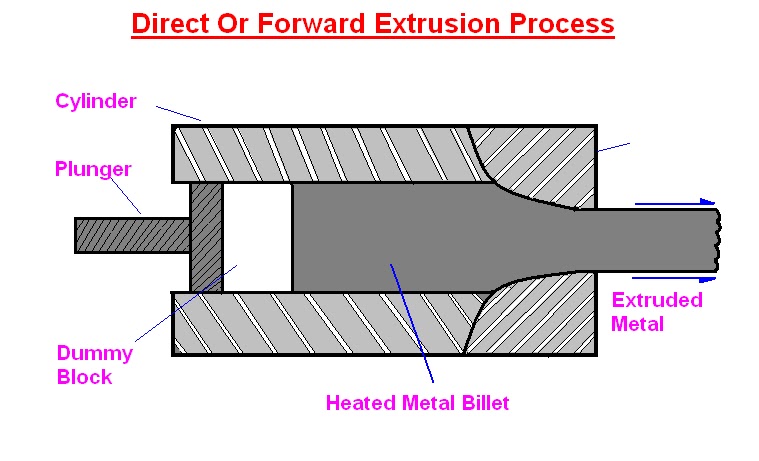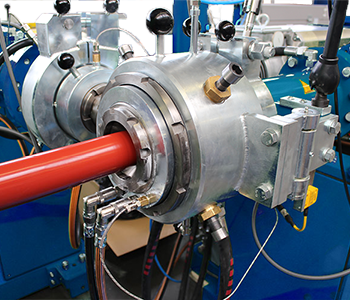What are the types of extrusion moulding?Extrusion moulding types include direct, indirect, tube, coextrusion, cold, hot, and blown film extrusion processes.

Types of Extrusion Moulding Processes
Extrusion moulding is a versatile manufacturing process that involves forcing material through a shaped die to produce items with a consistent cross-sectional profile. The types of extrusion moulding processes vary based on the material’s flow direction, temperature, and specific applications. This guide delves into the distinct methods, their advantages, and typical applications.
Direct Extrusion (Forward Extrusion)
Direct extrusion, often known as forward extrusion, is the most common type of extrusion moulding. Here’s a breakdown:
- Mechanism: Material is forced forward through a die.
- Applications: Producing rods, tubes, and hollow sections.
- Advantages: Cost-effective, more straightforward setup.
- Challenges: Uneven material flow can result in imperfect products.

Indirect Extrusion (Reverse Extrusion)
Unlike direct extrusion, indirect extrusion pushes the die, not the material. Here’s what you need to know:
- Mechanism: Die moves towards the stationary billet.
- Applications: Products requiring more delicate extrusion and intricate details.
- Advantages: Less friction, smoother product surface.
- Challenges: Requires specialized machinery.
Tube Extrusion (Blown Film Extrusion)
This process is primarily used for making thin film and sheet-like products:
- Mechanism: Molten material is extruded upward into a circular die, forming a bubble.
- Applications: Plastic bags, films, and agricultural coverings.
- Advantages: Enables the creation of thin films with consistent thickness.
- Challenges: Requires precise control to maintain uniform film thickness.
Coextrusion
Coextrusion involves multiple layers of material in a single extrusion process:
- Mechanism: Two or more materials are extruded simultaneously through a common die.
- Applications: Food packaging, multi-layer tubing, and barrier films.
- Advantages: Combines properties of multiple materials into one product.
- Challenges: Ensuring consistent flow of different materials.
Explore Coextrusion
Cold Extrusion
Cold extrusion processes material at or near room temperature:
- Mechanism: Material is pressed through a die without pre-heating.
- Applications: Aluminum cans, gear parts, and automotive components.
- Advantages: Superior surface finish and higher strength products.
- Challenges: Requires more force than hot extrusion.
Know more about Cold Extrusion
Hot Extrusion
As the name suggests, hot extrusion involves heat:
- Mechanism: Material is pre-heated before being forced through a die.
- Applications: Steel rods, non-ferrous alloy parts, and shapes with complex cross-sections.
- Advantages: Easier material flow and ability to form intricate shapes.
- Challenges: Oxidation risks and potential for material defects.
Profile Extrusion
Profile extrusion specializes in creating intricate cross-sectional profiles:
- Mechanism: Varying the shape of the die allows different profiles.
- Applications: Window frames, door frames, and decorative trims.
- Advantages: Versatility in designing custom profiles.
- Challenges: Ensuring uniform thickness throughout the profile.
Discover more on Profile Extrusion
Crosshead Extrusion
This process is used for creating insulation on wires and cables:
- Mechanism: The material is extruded perpendicular to the direction of the wire or cable.
- Applications: Electrical wiring, fiber-optic cables.
- Advantages: Accurate insulation thickness, high-speed application.
- Challenges: Maintaining concentricity and even insulation.

Details on Crosshead Extrusion
Tandem Extrusion
Tandem extrusion employs two or more extruders in a sequence:
- Applications: Multi-layered pipes, specialty compounds.
- Advantages: Combining different extrusion methods or materials in one continuous process.
- Challenges: Coordination between multiple extruders, material compatibility.
Learn about Tandem Extrusion
Ram Extrusion
An older method where the material is pushed by a ram through a die:
- Mechanism: A hydraulic ram pushes material through a die.
- Applications: PTFE (Teflon) rods and tubes.
- Advantages: Suitable for materials that don’t flow easily.
- Challenges: Slower process, not ideal for high-volume production.
Materials Used in Extrusion Moulding
The choice of material for extrusion moulding significantly influences the final product’s properties, appearance, and application. Here’s a detailed look into some of the most commonly used materials in the extrusion moulding process.
Polymers: Thermoplastics and Thermosetting Plastics
Polymers rank among the most versatile materials for extrusion due to their malleability and wide application range.
-
- Applications: PE for plastic bags and bottles, PVC for pipes and cable insulation, and PP for automotive parts.
- Advantages: Easy to process, recyclable, and offer diverse applications.
- Challenges: Sensitivity to high temperatures.Thermoplastics: These are polymers that become pliable when heated and solidify upon cooling. Common thermoplastics include Polyethylene (PE), Polypropylene (PP), and Polyvinyl Chloride (PVC).
- Applications: Epoxy resins for electronic components, phenolics for billiard balls and knobs.
- Advantages: High thermal stability and resistance to solvents.
Metals: Aluminum, Copper, Steel, etc.
Metals bring strength and durability to extruded products, making them vital for many industrial applications.
-
- Applications: Window frames, automotive parts, and kitchen utensils.
- Advantages: Lightweight, malleable, and resistant to rust.
- Challenges: Sensitive to rapid temperature changes.Aluminum: Lightweight, corrosion-resistant, and excellent conductivity.
- Applications: Electrical wires, roofing materials, and heat exchangers.
- Advantages: High conductivity, corrosion resistance, and ductility.
- Challenges: Higher cost compared to other metals.Copper: Renowned for its excellent electrical conductivity.
- Steel: Offers strength and durability.
- Applications: Construction beams, automotive components, and tools.
- Advantages: High strength and durability.
- Challenges: Prone to corrosion unless treated.
Ceramic and other materials
Ceramics, often non-metallic solids, are hard, brittle, and heat-resistant, making them suitable for specific extrusion applications.
- Mechanism: Often extruded in a semi-dry state using a screw or piston.
- Applications: Spark plug insulators, cutting tools, and structural tiles.
- Advantages: High melting points, chemical resistance, and electrical insulating properties.
- Challenges: Brittle nature and difficulty in processing.
Equipment and Machinery for Extrusion Moulding
Extrusion moulding, as a predominant manufacturing technique, relies heavily on specialized machinery and equipment. Here’s a detailed overview of the core equipment involved in the extrusion moulding process.
Extruders: Single Screw vs. Twin Screw
At the heart of the extrusion process is the extruder, responsible for melting and conveying the material.
- Single Screw Extruders: Consists of a single rotating screw within a cylindrical barrel.
- Applications: Basic extrusion tasks, especially with polymers.
- Advantages: Simple design, cost-effective, and easy to maintain.
- Challenges: Limited mixing capability and potential for inconsistent output.
- Twin Screw Extruders: Features two intermeshing screws.
- Applications: Complex extrusion tasks, compounding, and mixing additives.
- Advantages: Superior mixing, versatility, and high output rates.
- Challenges: More complex design and higher initial investment.
Dies and Tooling
The die defines the shape and profile of the extruded product.
- Mechanism: Material flows through the die to take its final shape.
- Applications: Varied, based on the intended product, from pipes to profiles.
- Advantages: Customizability for different shapes and sizes.
- Challenges: Dies require precise machining and regular maintenance.
Auxiliary Equipment
Beyond the primary extruder and dies, several auxiliary machines optimize and complement the extrusion process.
- Feeders: Ensure a consistent supply of material to the extruder.
- Applications: Metering materials like polymers, additives, or fillers.
- Advantages: Steady material feed results in consistent product quality.
- Challenges: Requires synchronization with the extruder’s speed.
- Cooling and Sizing Equipment: Maintains product shape post-extrusion.
- Applications: Cooling extruded products uniformly to retain their shape.
- Advantages: Rapid cooling enhances productivity.
- Challenges: Ensuring even cooling to prevent deformities.
- Pullers and Cutters: Cut the extruded product to desired lengths.
- Applications: Producing segments of consistent length.
- Advantages: Allows for automated, high-speed production.
- Challenges: Precision is essential to maintain product consistency.
Applications and End Products of Extrusion Moulding
Extrusion moulding has found its foothold in various industries owing to its efficiency, versatility, and cost-effectiveness. This transformative process morphs basic materials into products and components that we encounter daily. Let’s explore some key applications and the resulting products birthed from the extrusion moulding process,What are the types of extrusion moulding?.
Extruded Profiles: Windows, Doors, etc.
Extruded profiles cater to a broad range of applications, predominantly in the construction and furniture sectors.
- Mechanism: By passing material through specially designed dies, custom cross-sectional profiles are formed.
- Applications: The resultant shapes are found in window frames, door frames, railings, and more.
- Advantages: These profiles can be manufactured in long lengths and can be cut down as per requirement, offering flexibility in design and use.
- Challenges: Maintaining uniformity in complex profiles and ensuring that they fit industry standards.
Films and Sheets
Thin extruded materials, either in the form of films or sheets, play a crucial role in packaging, insulation, and other sectors.
- Mechanism: Material is extruded through a flat die and then either rolled or stretched to achieve desired thickness and finish.
- Applications: Packaging material, protective layers, overhead projector sheets, and more.
- Advantages: Tailored thickness and properties such as transparency, flexibility, or UV resistance.
- Challenges: Achieving uniform thickness across large areas and ensuring material stability.

Pipes and Tubing
Extrusion moulding is vital in producing various pipes and tubes used in construction, plumbing, and transportation.
- Mechanism: Material is extruded through a circular die, solidifying in the desired tubular shape as it cools.
- Applications: Plumbing pipes, gas lines, water hoses, medical tubing, and more.
- Advantages: Seamless construction ensures strength and leak resistance, with options for varying diameters and wall thicknesses.
- Challenges: Ensuring consistent wall thickness and managing materials that might sag or deform post-extrusion.
Wires and Cables
The protective insulation around most electrical wires and cables comes courtesy of the extrusion process.
- Mechanism: The metal wire or cable runs through the extruder, where an insulating layer of polymer or rubber is applied around it.
- Applications: Household wiring, data cables, high-voltage power lines, and more.
- Advantages: Consistent, tight insulation enhances electrical safety and performance.
- Challenges: Maintaining concentric insulation and avoiding air bubbles or imperfections.




